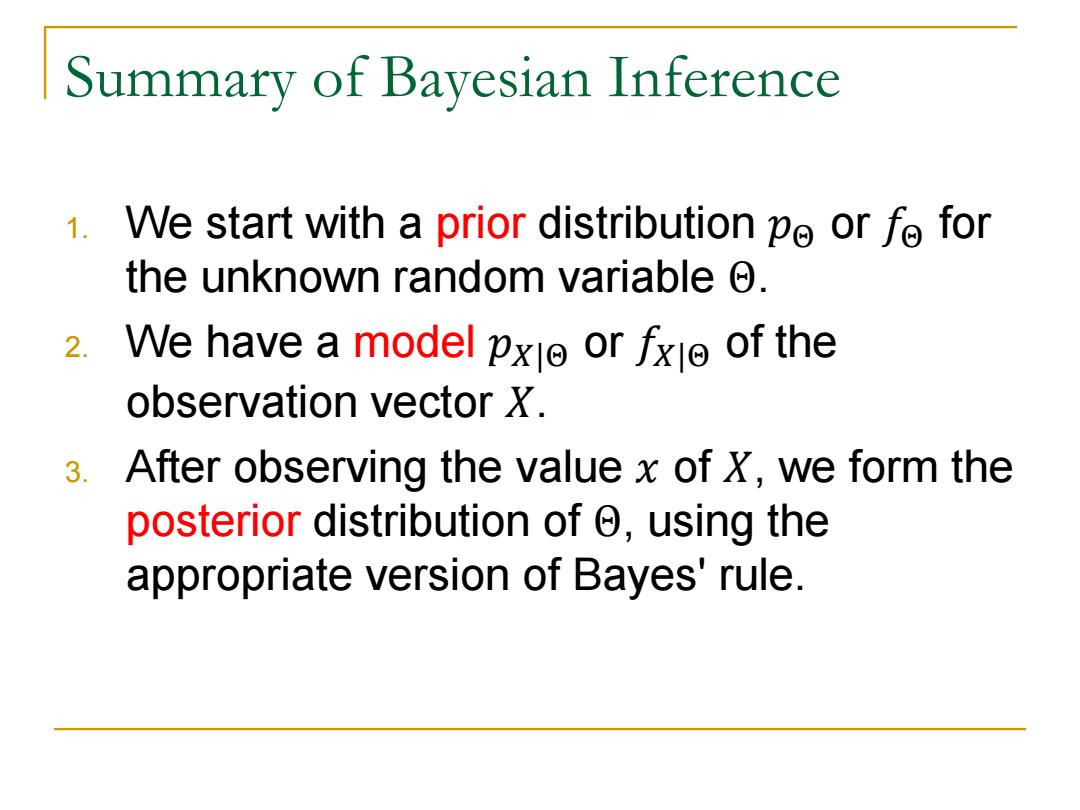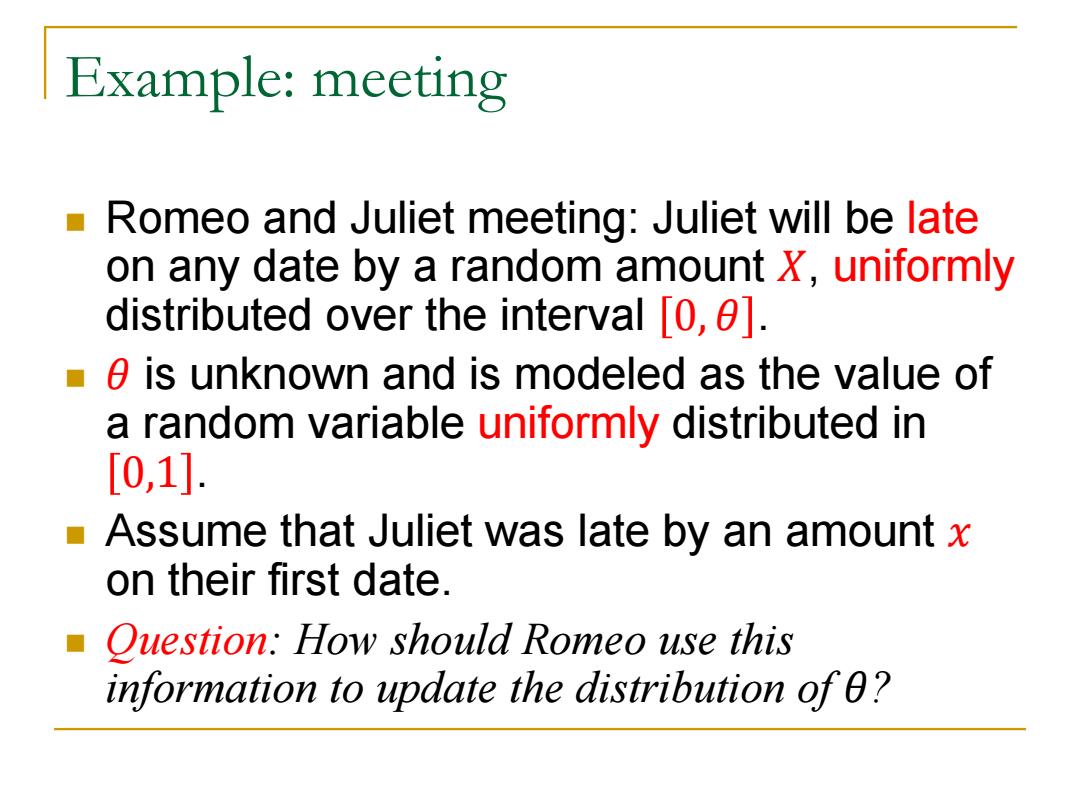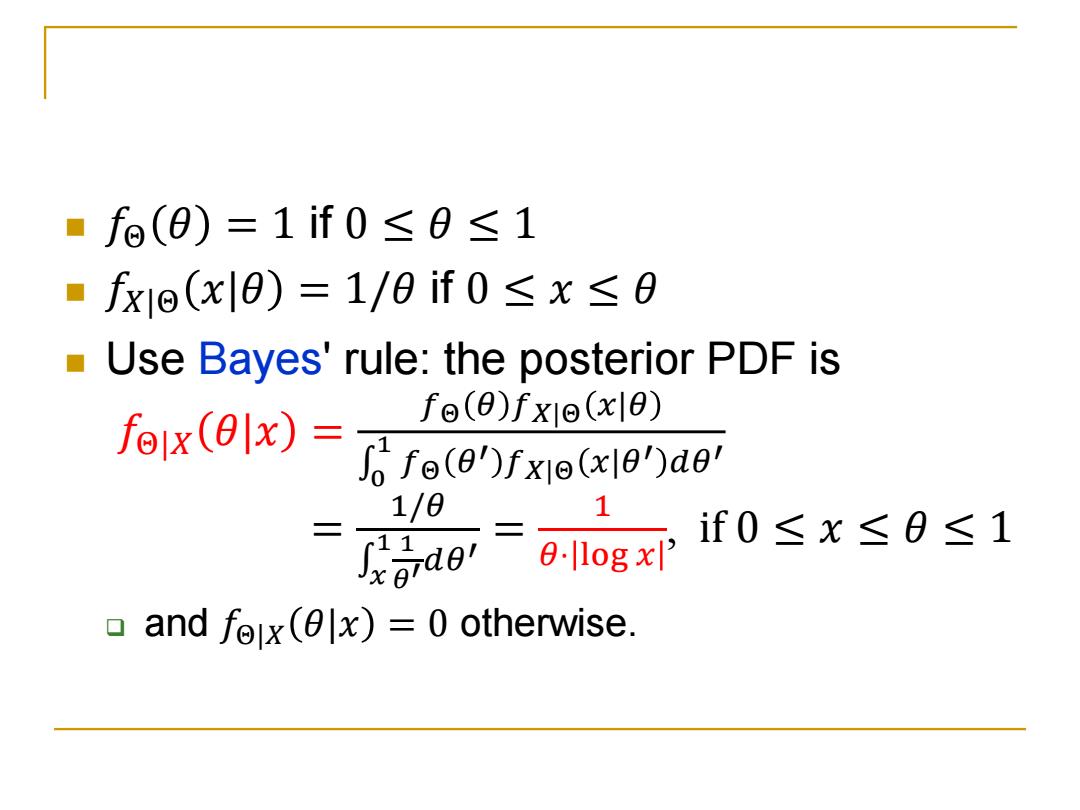
Summary of Bayesian Inference 1.We start with a prior distribution po or fo for the unknown random variable 6. 2.We have a model pxie or fxie of the observation vector X. 3.After observing the value x of X,we form the posterior distribution of 6,using the appropriate version of Bayes'rule
Summary of Bayesian Inference 1. We start with a prior distribution 𝑝Θ or 𝑓Θ for the unknown random variable Θ. 2. We have a model 𝑝𝑋|Θ or 𝑓𝑋|Θ of the observation vector 𝑋. 3. After observing the value 𝑥 of 𝑋, we form the posterior distribution of Θ, using the appropriate version of Bayes' rule

Bayes'rule:summary The Four Versions of Bayes'Rule .e discrete,X discrete: Depending on discrete pe1x(8|x)= pe(0)pxle(x10) or continuous 6 and X. ∑Pe(0pxe(ay there are four versions .e discrete,X continuous: of Bayes'rule. Pe1x(0|x)= pe()fx1e(x|θ) ∑pe(e)fxlo(zl0) They are syntactically .e continuous,X discrete: all similar. fa1x(8|r)= fe(0)pxle(10) fe(0)pxIe(x|θ)de ●曰continuous,.X continuous: fa()fxe(x|θ) fa1x(81x)= Ife(@)fx()do
Bayes’ rule: summary Depending on discrete or continuous Θ and 𝑋, there are four versions of Bayes' rule. They are syntactically all similar

Example:meeting Romeo and Juliet meeting:Juliet will be late on any date by a random amount X,uniformly distributed over the interval [0,0]. _0 is unknown and is modeled as the value of a random variable uniformly distributed in [0,1]. ■ Assume that Juliet was late by an amount x on their first date. Question:How should Romeo use this information to update the distribution of 0?
Example: meeting Romeo and Juliet meeting: Juliet will be late on any date by a random amount 𝑋, uniformly distributed over the interval 0, 𝜃 . 𝜃 is unknown and is modeled as the value of a random variable uniformly distributed in 0,1 . Assume that Juliet was late by an amount 𝑥 on their first date. Question: How should Romeo use this information to update the distribution of 𝜃?

.Por P元)={& f0≤0≤1, otherwise. Conditional PDF of the observation: 6w60= if0≤x≤0, )otherwise
Prior PDF: 𝑓Θ 𝜃 = ቊ 1 if 0 ≤ 𝜃 ≤ 1, 0 otherwise. Conditional PDF of the observation: 𝑓𝑋|Θ 𝑥|𝜃 = ቊ 1/𝜃 if 0 ≤ 𝑥 ≤ 𝜃, 0 otherwise

■fo(8)=1if0≤0≤1 ·fxIe(x|8)=1/0if0≤x≤8 Use Bayes'rule:the posterior PDF is felx(0lx)= fo(e)fxo(xle) e()x(x 1/0 1 orde-log if0≤x≤8≤1 and fox(x)=0 otherwise
𝑓Θ 𝜃 = 1 if 0 ≤ 𝜃 ≤ 1 𝑓𝑋|Θ 𝑥|𝜃 = 1/𝜃 if 0 ≤ 𝑥 ≤ 𝜃 Use Bayes' rule: the posterior PDF is 𝑓Θ|𝑋 𝜃|𝑥 = 𝑓Θ 𝜃 𝑓𝑋|Θ 𝑥|𝜃 0 1 𝑓Θ 𝜃′ 𝑓𝑋|Θ 𝑥|𝜃′ 𝑑𝜃′ = 1/𝜃 �� 1 1 𝜃′𝑑𝜃′ = 1 𝜃⋅ log 𝑥 , if 0 ≤ 𝑥 ≤ 𝜃 ≤ 1 and 𝑓Θ|𝑋 𝜃|𝑥 = 0 otherwise